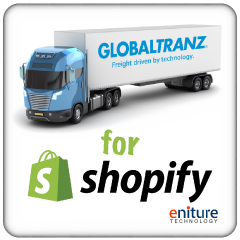The GlobalTranz LTL Freight Quotes app retrieves your negotiated LTL rates, takes action on them according to the app settings, and displays the results as shipping options in the Shopify checkout process. GlobalTranz (globaltranz.com) is a third-party logistics company that gives its customers access to dozens of LTL freight carriers through a single account relationship. GlobalTranz is a privately held company that has $1.8 Billion in annual revenue, placing it inside the top 10 largest privately held companies in the United States. To establish a GlobalTranz account call 866-275-1407 or fill out its Contact Us form.
Setup Tutorial & Demo (6 min)
Basic Plan $20/month
Retrieves your negotiated LTL freight rates.
Access to dozens of LTL carriers.
Offer the cheapest rate, an average rate, or a list of options.
Supported origins: United States.
Supported destinations: Canada, United States.
Customize the text used to label quotes displayed to shoppers.
Elect to display the carrier’s transit time with the rate estimate.
Define multiple warehouse locations.
Identify products that drop ship from vendors.
Compatible with Shopify Locations.
Basic option for residential delivery.
Basic option for lift gate delivery.
Basic option for notify before delivery.
Basic option for limited access delivery.
Mark up quotes by a dollar amount or percentage.
Assign products and variants a shipping weight, freight class and optionally dimensions.
Access to a built in density calculator.
Pallet Packaging feature which is required for merchants with density-based tariffs and is optional for merchants with Freight Class/NMFC based tariffs. A step-by-step graphical illustration of the packaging solution is saved with the order.
Support for items that ship as multiple handling units (e.g. pallets). (Requires use of the optional Pallet Packaging feature)
Dynamic presentation of parcel and LTL freight rates with the installation of compatible apps from Eniture Technology
Standard Plan $25/month
Everything in the Basic Plan, plus…
Apply a daily cut-off time and add processing days so the quoted ship date aligns with actual shipping days.
Automatic detection of residential addresses allows the carrier’s residential delivery fee to be automatically included in quotes.
Option to require lift gate delivery when a residential address is detected.
Allow customers to choose between a standard option for LTL freight and one that includes lift gate delivery.
Offer customers the option to choose a quote that includes notify before delivery service.
Offer customers the option to choose a quote that includes limited access delivery service.
Do not display rates if a post office box is detected.
Support for products that ship hazardous material.
Advanced Plan $40/month
Everything in the Standard Plan, plus…
Offer and option for in-store pick up based on the customer’s distance from your warehouse.
Offer local delivery based on the customer’s distance from your warehouse.
Charge a fee for local delivery.
Support for products that can be nested when shipped, such as garbage cans or drinking cups.
Current version: 1.0
Requirements
A Shopify account with the Real-Time Carrier Shipping feature enabled. The feature is standard on the Advanced Shopify subscription package. It can be added to other packages by contacting Shopify customer service.
An established account with GlobalTranz or Cerasis.
FAQ’S
How do I get this application?
This application can only be installed from the Shopify App Store. Click here to locate the app in the Shopify App Store and then click the “Add app” button to install it. You must have the Shopify store owner credentials to perform the installation.
How do I get a GlobalTranz or Cerasis account number?
For GlobalTranz, call 866-275-1407 or fill out its Contact Us form.
For Cerasis call 1-800-734-5351 or click here to complete a form that will immediately provide you with credentials to use with the extension and also initiate the new account process.
Where do I find my GlobalTranz or Cerasis username and password?
If you know you have credentials and just don’t remember your passwords, use the “Forgot password” link for the type of account you have:
GlobalTranz Forgot Password Link
Cerasis Forgot Password Link
If you need more than the “Forgot password” link, contact the company by phone:
GlobalTranz: 866-275-1407
Cerasis: 800-734-5351
Where do I get my API Access Key?
Please refer to the User Guide for instructions on how to obtain the API Access Key for both GlobalTranz and Cerasis.
Why were the shipment charges I received on the invoice different than what was quoted by the application?
The rates will be the same if the shipment parameters used to obtain the quote are exactly the same as those that were used for the invoice. Compare the shipment parameters in the application with those on the invoice. Pay close attention to freight class, product weight, dimensions, and any accessorial fees like residential delivery. Consider making changes as needed. Remember that the weight of packaging materials is included in the weight of the shipment and that your use of pallet or box size may have an impact on the shipment’s billable weight. If you are unable to reconcile the differences call GlobalTranz or Cerasis for assistance.
What happens when my shopping cart contains products that ship LTL and products that would normally ship FedEx or UPS?
If the shopping cart contains one or more products tagged to ship LTL freight, all of the products in the shopping cart are assumed to ship LTL freight. To ensure the most accurate quote possible, make sure that every product has a freight class, weight and dimensions recorded.
What happens if I forget to identify a freight classification for a product?
In the absence of a freight class, the plugin will attempt to calculate the freight classification using the density calculation method. To do so the products weight and dimensions must be recorded. This is not a reliable alternative and identifying the proper freight class will always return the most reliably accurate result.
How do I find out what freight classification to use for my products?
Look over our knowledge base article on the topic.
Why do I sometimes get a message that a shipping rate estimate couldn’t be provided?
There are several possibilities:
There wasn’t enough information about the weight or dimensions for the products in the shopping cart to retrieve a shipping rate estimate.
The GlobalTranz or Cerasis web service isn’t operational.
Your GlobalTranz or Cerasis account has been suspended or cancelled.
There is an issue with the Eniture Technology servers.
There is an issue with the Shopify servers.
How does the density calculator work?
The density calculator will calculate a freight class by performing a calculation using the product weight and dimensions as inputs. In most cases, the returned freight class will match the product’s (commodity’s) freight class as recorded in the National Motor Freight Classification (NMFC) directory. However, this is not always true and in the event there are differences, the freight class recorded in the National Motor Freight Classification (NMFC) directory takes precedence. An incorrectly identified freight class can result in unexpected shipping charges and even fees. You are solely responsible for accurately identifying the correct freight class for your products. If you need help doing this, contact GlobalTranz or Cerasis for assistance.
User’s Guide
To install this app you must be signed into Shopify with the store owner’s credentials.
Setting up the application to display LTL freight quotes consists of the following steps:
- Prepare Shopify to use the application.
- Obtain your API credentials.
- Choose the desired plan.
- Connect the application to the API.
- Select which carriers to retrieve quotes for.
- Identify your warehouse and drop ship locations.
- Choose the desired quote settings.
- Identify pallet sizes.
- Shipping Rules.
- Enter the product shipping parameters.
Other information contained in this guide:
1. Prepare Shopify to use the application |
Return to top. |
You must have the Third-party calculated shipping rates feature on your Shopify plan to have live carrier quotes displayed in the checkout process. It is standard on the Shopify Advanced plan and can be added to other Shopify plans by calling Shopify Customer Service at 888-746-7439. (Learn more)Navigate to the Settings>Shipping page. Click on the Manage rates link for the General shipping rates in the Rates at checkout section.

In the General shipping profile, locate the shipping origin from which you want the app to provide quotes.

If the only shipping zone you have is Rest of world, click on the Create shipping zone link and then enter a zone name (i.e. “Domestic”).
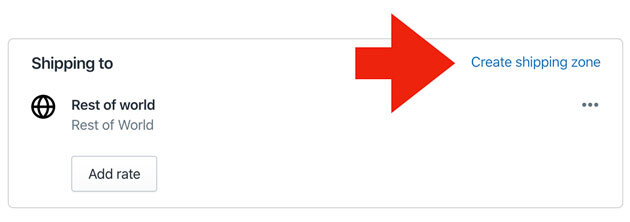
Locate the shipping zone for which you want to app to provide quotes. Click the Add rate button.
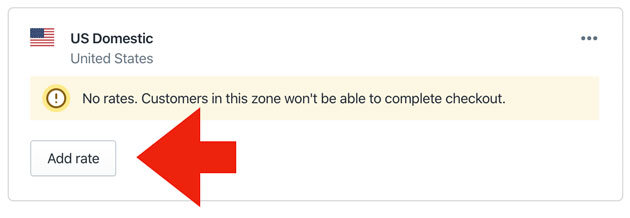
Select the option Use carrier or app to calculate rates.
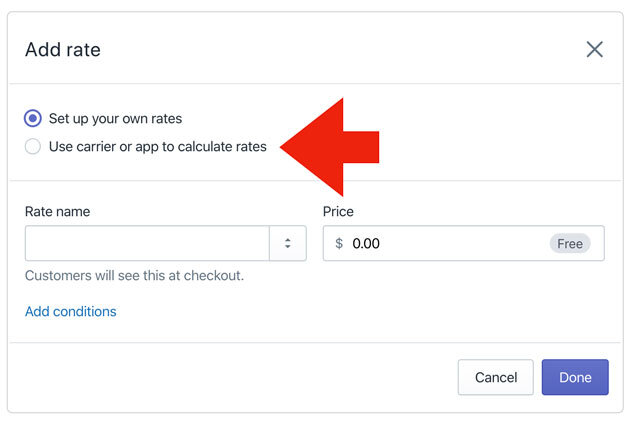
It may take a moment for Shopify to retrieve the list of apps capable of providing shipping quotes for your store. After it has, the appearance of the Add rate page will be similar to the image below. Perform the following actions:
- Select the app from the drop down list.
- Enable the Services are selected in the app preferences setting. If this setting isn’t available to enable, don’t be concerned. Click the Done button at the bottom of the page and continue on to the next step.
- Click the Done button at the bottom of the page.
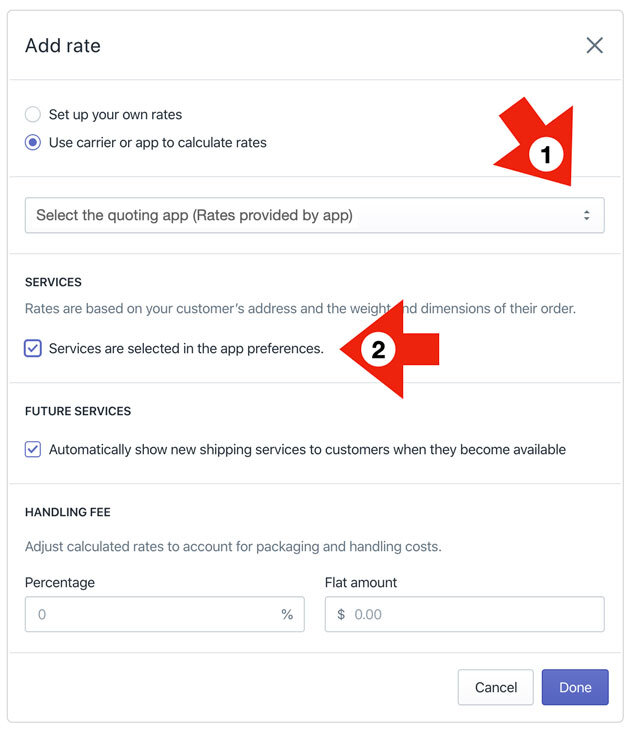
Repeat the steps above to enable the app for any other shipping zone. You should only enable the app in shipping zones that the app is capable of returning quotes for. Check the Features tab for origins and destinations that the app supports.
2. Obtain your API credentials |
Return to top. |
To retrieve your negotiated rates, the app needs to establish a connection with either Cerasis or GlobalTranz through an Application Programming Interface, or “API”. To make the connection, you’ll need to obtain an “API Access Key” for your account. Follow the instructions in either Step 2a or Step 2b for the type of account you have.
2a. Cerasis API |
Return to top. |
If you are an existing Cerasis customer, call Cerasis at 1-800-734-5351 to request your API Access Key.
If you don’t have a Cerasis account number and want to connect the app to the Cerasis Rater API, call Cerasis at 1-800-734-5351 to request an account or click here to complete a form that will immediately provide you with credentials to use with the app. Completing the form will also initiate the new account process.
2b. GlobalTranz Legacy API |
Return to top. |
If you’re an existing GlobalTranz customer, email apisupport@globaltranz.com to request your GlobalTranz API Access Key. In the email, include your GlobalTranz account number and make it clear that you are requesting the “API Access Key” for your account.
If you don’t have a GlobalTranz account number and want to connect the app to the GlobalTranz API, call 866.275.1407 to request an account.
3. Choose the desired plan. |
Return to top. |
Begin by selecting Apps from the Shopify menu. Locate the entry for the Cerasis LTL Freight Quotes app and click on the app name to access the app preferences.
![]()
The Plans page is used to confirm the plan you are currently subscribed to, see the features offered on each plan, and to perform upgrades or downgrades according to your needs. The plan you’re currently subscribed to will have This is your current plan above the monthly subscription rate. To change plans, click on the desired plan’s monthly subscription rate. You must be signed into Shopify with the Store Owner credentials to change plans.
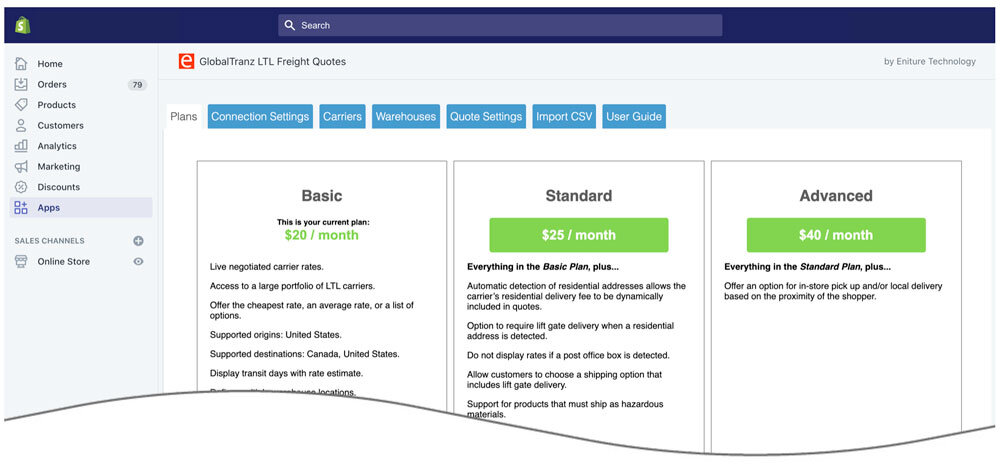
4. Connect the application to the API |
Return to top. |
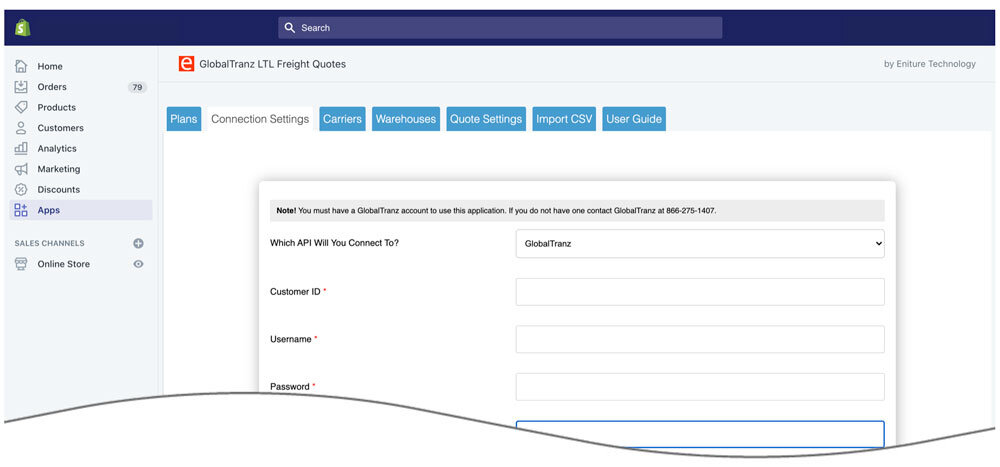
The Connection Settings page is used to establish the plugin’s connection to GlobalTranz’s web services. What is required depends on whether you will connect to the Cerasis API, the GlobalTranz Legacy API, or the GlobalTranz New API. The Which API will you connect to? setting will determine whether you will complete this step using the instructions in section 4a, 4b, or 4c.
| Which API will you connect to? | Cerasis Choose this option if you have credentials to Cerasis API. If you select this option, proceed to Step 4a. GlobalTranz
Choose this option if you have credentials to GlobalTranz’s legacy API. If you select this option, proceed to Step 4b. New API
Choose this option if you obtained a Client ID and Client Secret to use when connecting to the new GlobalTranz API. Instructions on how to obtain these is presented earlier in this guide. If you select this option, proceed to Step 4c. |
4a. Connect to the Cerasis API |
Return to top. |
The instructions in this section are relevant only if you selected the Cerasis option for the Which API will you connect to? setting.
Enter the information prompted for, then click Save Settings. After saving the settings, click the Test Connections button. You will see a success message if your credentials validated. If the connection fails, correct the credentials and try again. Advance to Step 6 when you’ve completed this step.
| Shipper ID | Enter your account number. |
| Username | Enter the username you use to log into Cerasis Rater |
| Password | Enter the password associated with the username entered above. |
| Access Key | Enter the API Access Key you obtained in Step 2. |
4b. Connect to the GlobalTranz Legacy API |
Return to top. |
The instructions in this section are relevant only if you selected the GlobalTranz option for the Which API will you connect to? setting.
Enter the information prompted for, then click Save Settings. After saving the settings, click the Test Connections button. You will see a success message if your credentials validated. If the connection fails, correct the credentials and try again. Advance to Step 6 when you’ve completed this step.
| Customer ID | Enter your account number for the selected API. |
| Username | Enter the username you use to log into GTZship. |
| Password | Enter the password associated with the username entered above. |
| Access Key | Enter the API Access Key you obtained in Step 2. |
4c. Connect to the GlobalTranz New API |
Return to top. |
The instructions in this section are relevant only if you selected the New API option for the Which API will you connect to? setting.
Enter the information prompted for, then click Save Settings. After saving the settings, click the Test Connections button. You will see a success message if your credentials validated. If the connection fails, correct the credentials and try again. Advance to Step 6 when you’ve completed this step.
| Client ID | Enter the Client ID you received for the New API. |
| Client Secret | Enter the Client Secret you you received for the New API. |
5. Select Carriers |
Return to top. |
Click on the Carriers tab. Check the boxes adjacent to the carriers that you want to receive quotes from. Usually, it’s best to retrieve quotes from all the carriers you have access to. You’ll limit what your shopper sees on the Quote Settings page explained later in these instructions. However, if there are particular carriers you have strong feelings against, this is where you will omit them.Be sure to click the Save Settings button at the bottom of the page.
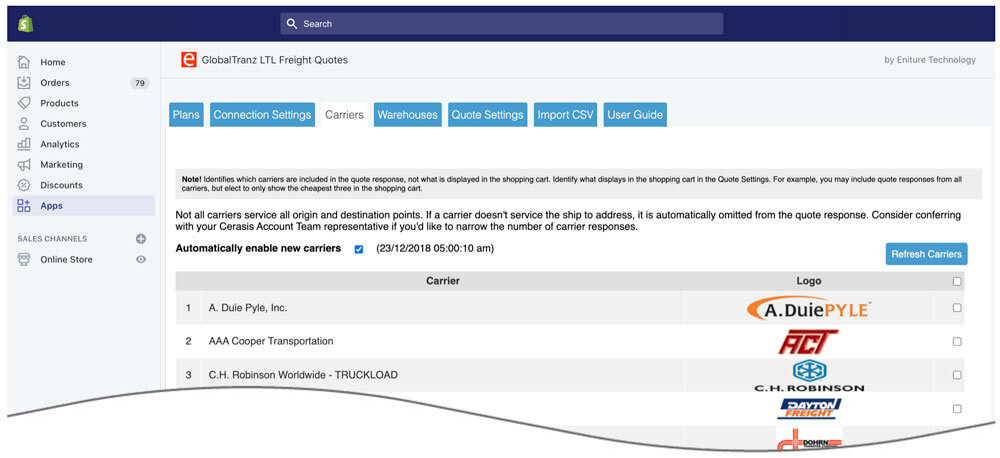
6. Identify Warehouse and Drop Ship Locations |
Return to top. |
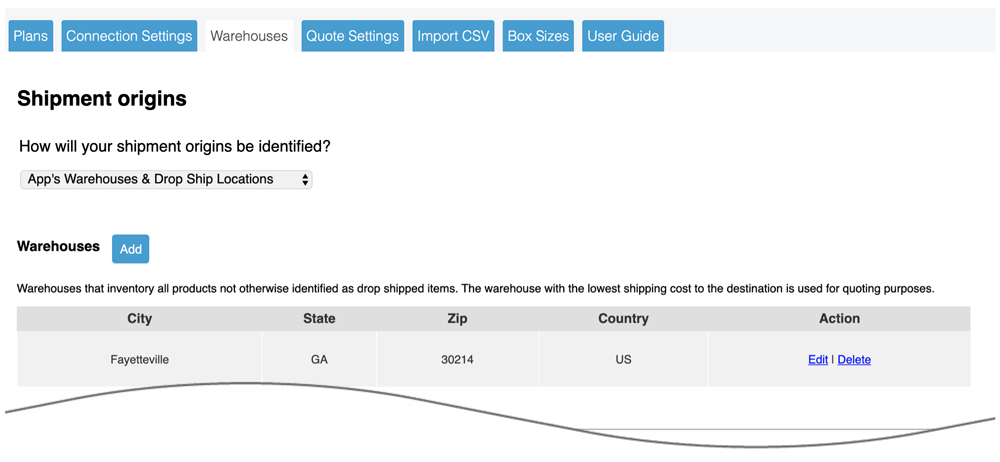
You can choose to use the app’s warehouse and drop ship functionality, or Shopify’s Locations feature to determine the shipment origins for orders placed on your store. Make your selection using the drop-down field labeled, How will your shipment origins be identified?
If you ship from only one location, it doesn’t matter which option you choose. However, your decision will matter if you ship from more than one location.
The app’s functionality assumes than an unlimited amount of inventory is available from each stocking location. The app has two types of stocking locations: warehouses and drop ship locations. If multiple warehouses exist, the one closest to the ship-to address is used as the ship-from location. This approach minimizes the estimated shipping costs and, if you have the setting enabled, presents your shopper with quicker estimated delivery dates. When an item is assigned to a drop ship location, it always ships from there.
Shopify Locations introduces the ability to do inventory tracking at multiple locations. Shopify Locations may be a good option for you if:
- You have visibility to the inventory levels at all your shipping locations.
- You will maintain accurate inventory counts in Shopify.
- You have items that can ship from more than one location, but not all locations.
Be aware that Shopify’s selection of the ship-from location isn’t influenced by its proximity to the ship-to address. Instead, you’ll list your locations in the order in which you want Shopify to look for available inventory. Once Shopify finds it, that location (or locations) becomes the ship-from address even if the next one on your list is across the street from the ship-to address and has enough inventory to fulfill the order. To get a better understanding of how Shopify Locations identifies the ship-from location, look over the example borrowed from Shopify’s Help Center.
If you choose to use Shopify Locations, you’ll lose visibility to how the app built the shipping quote when Shopify determines that more than one location is needed to fulfill the order. This occurs because Shopify makes individual shipping rate requests for each location and doesn’t provide enough information to relate each of them back to the same order. The section in this document titled, What you see, has examples of the information normally captured with an order. This information will be missing when Shopify Locations is used, and more than one location is used to fulfill the order.
Click the Add button in the appropriate sections to add warehouse and drop ship locations. Warehouses should have a complete inventory of all products not otherwise assigned to a drop ship location. If you have more than one warehouse defined, the warehouse closest to the shopper will be used to retrieve shipping rate estimates.
Drop ship locations usually represent vendors that supply items that you don’t inventory. These items are shipped directly to your customer on your behalf. An item can be assigned to only one drop ship location. Items not assigned to a drop ship location are assumed to ship from your warehouse(s).
When an order will ship from more than one stocking location (e.g. warehouse and drop ship locations or more than one drop ship location) a single figure will display for the shipping rate estimate labeled “Shipping”. The amount of the quote will be equal to the sum of the cheapest shipping option for each location.
A best practice is to define at least one warehouse, even if all your products are drop shipped. If all your products are drop shipped (you have no warehouses), make the highest volume drop ship location a warehouse. This ensures that shipping rate estimates will still be returned in the event a product was added to your catalog and its drop ship location wasn’t identified.
Warehouses vs. Drop Ship Locations
How the App Presents Quotes with Multiple Shipment Origins
The locations you identified in Shopify will be displayed on the page when you select Shopify Locations from the How will your shipment origins be identified? drop down. Any changes to your locations will need to be made in Shopify. If you are on the app’s ADVANCED plan you can use the Edit link to enable and manage your in-store pickup and local delivery settings.
The Pitfalls of Shopify Shipping
6a. In-store pick up settings |
Return to top. |
The Advanced Plan is required to use this feature. If you aren’t on the Advanced Plan the words Advanced plan required will appear adjacent to the settings header, and the fields associated with the feature will be inaccessible.

Click on the text Advanced plan required to upgrade your plan and gain access to the feature. You must be signed into Shopify with the Store Owner credentials to perform the upgrade.
In-store pick up can be offered as an option in the checkout process based the shopper’s postal code or proximity. It will only be offered if the feature is enabled and only one stocking location (warehouse or drop ship location) is involved in providing a quote. The settings for In-store pick up are visible on the page used to add or edit a warehouse or drop ship location.
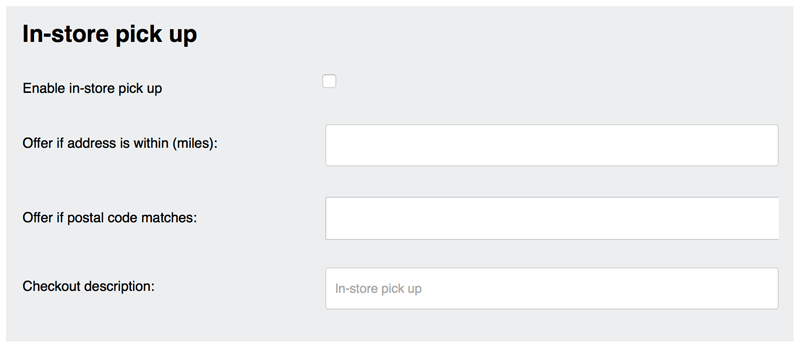
| Enable in-store pick up | Check the box to enable the in-store pick up feature. |
| Offer if address is within (miles) | The distance in miles within which you’d like to offer in-store pick up. The distance is route miles (driving distance). Leave blank if you don’t want to use distance to determine if in-store pick up should be offered. If both distance and postal codes are used as evaluation criteria, in-store pick up will display if either is satisfied. |
| Offer if postal code matches | The postal codes to which you’d like to offer in-store pick up. Enter only the five digit ZIP Code for US addresses. Leave blank if you don’t want to use postal codes to determine if in-store pick up should be offered. If both distance and postal codes are used as evaluation criteria, in-store pick up will display if either is satisfied. |
| Checkout description | The description to use to identify the option in the checkout process. The most obvious candidate is In-store pick up, but you can make it anything you’d like. |
| In-store pickup fee | Enter an amount, in dollars (e.g. 5.00), that you want to charge for in-store pick up. Leave this field blank if you don’t charge for in-store pick up. |
6b. Local delivery settings |
Return to top. |
The Advanced Plan is required to use this feature. If you aren’t on the Advanced Plan the words Advanced plan required will appear adjacent to the settings header, and the fields associated with the feature will be inaccessible.

Click on the text Advanced plan required to upgrade your plan and gain access to the feature. You must be signed into Shopify with the Store Owner credentials to perform the upgrade.
Local delivery can be offered as an option in the checkout process based the shopper’s postal code or proximity. It will only be offered if the feature is enabled and only one stocking location (warehouse or drop ship location) is involved in providing a quote. Local delivery can display as a free option or have a charge associated with it. Other shipping options provided by the app can be suppressed when local delivery is to be offered. The settings for Local delivery are visible on the page used to add or edit a warehouse or drop ship location.
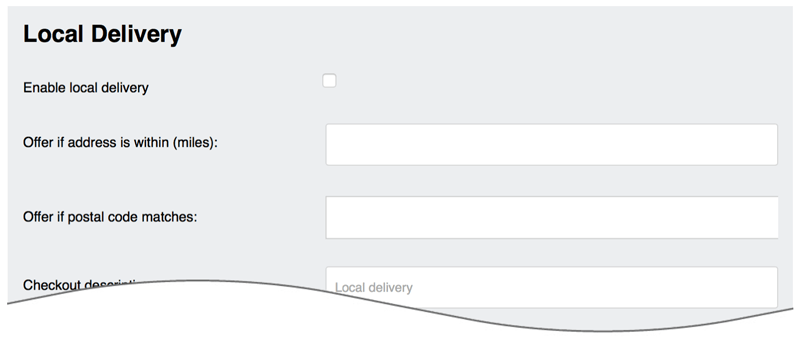
| Enable local delivery | Check the box to enable the local delivery feature. |
| Offer if address is within (miles) | The distance in miles within which you’d like to offer local delivery. The distance is route miles (driving distance). Leave blank if you don’t want to use distance to determine if local delivery should be offered. If both distance and postal codes are used as evaluation criteria, local delivery will display if either is satisfied. |
| Offer if postal code matches | The postal codes to which you’d like to offer local delivery. Enter only the five digit ZIP Code for US addresses. Leave blank if you don’t want to use postal codes to determine if local delivery should be offered. If both distance and postal codes are used as evaluation criteria, local delivery will display if either is satisfied. |
| Checkout description | The description to use to identify the option in the checkout process. The most obvious candidate is Local delivery, but you can make it anything you’d like. |
| Local delivery fee | Enter the amount to charge for local delivery. Leave blank to offer local delivery for free. |
| Suppress other rates | Check the box to show only the option for local delivery when the criteria for doing so (distance or postal code) is met. Leave unchecked to have local delivery offered in addition to the shipping options normally displayed by the app. |
7. Choose Quote Settings |
Return to top. |
On this page you’ll choose the settings that will affect every LTL freight quote your shopper sees. Enter the information prompted for, and then click on the Save Settings button at the bottom of the page.
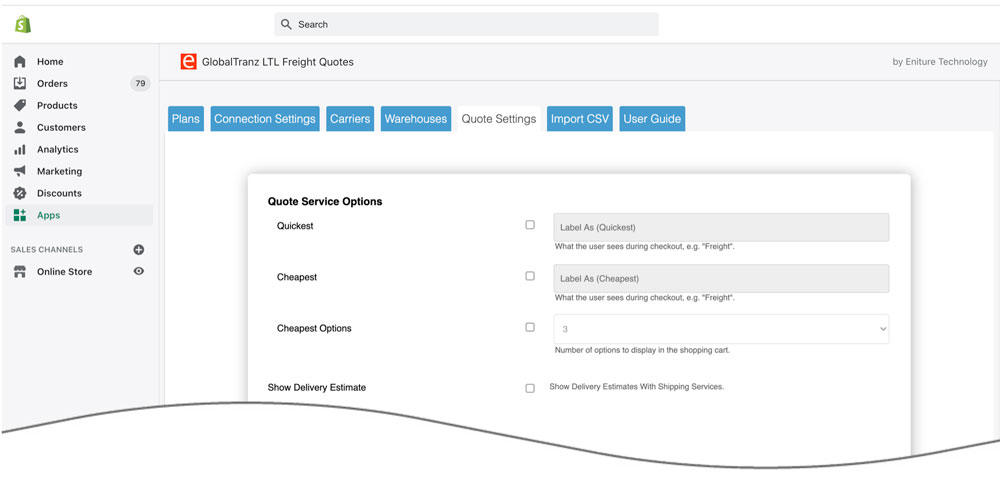
7a. GlobalTranz Quote Settings |
Return to top. |
| Quote Service Options | Enable the quote you want to provide from one of the three options:
|
| Show Delivery Estimate | Enable this setting to have the delivery estimate shown with the quote. |
| Show Guaranteed Options | Enable this setting to have guaranteed service options included when available. |
| Residential address settings | Do not return rate if the ship-to address appears to be a post office box Enable this setting if you don’t want the application to present shipping quotes when the ship-to address appears to be a post office box. If the app is on the BASIC subscription plan, text string matching is used to identify post office boxes. This method is not infallible or guaranteed. When the app is on the STANDARD or ADVANCED subscription plan, post office boxes in the United States are reliably identified through an API sourced from the US Postal Service. Text string matching will continue to be used for other countries. Always quote residential delivery
Enable this setting if you want the residential delivery fee always included in shipping rate estimates. Automatically detect residential addresses
The Standard Plan is required to use this settings. Enable this setting to have the app determine if the ship-to address is a residential address. If it is, the freight quote(s) will include the residential delivery fee. This setting allows the address type to be determined real-time so that quotes to commercial addresses don’t include the residential delivery fee. Default unconfirmed address types to:
Displays only if the Automatically detect residential addresses setting is enabled. In rare cases, the app may be unable to confirm the address type. This occurs when a match for the address can’t be found in the USPS database. Invalid addresses are the most common reason for this. In rare cases an address may be valid, but the match found in the USPS database has a low confidence metric. Choose how you want addresses treated in these cases.
Residential
Default. Choose this option if you want unconfirmed address types to be treated as residential. Commercial
Choose this option if you want unconfirmed address types to be treated as commercial. Address type disclosure:
Inform the shopper when ship-to address is identified as a residential address
Default. When enabled, the visitor will be informed if the shipping quote includes the residential delivery fee. Don’t disclose the address type to the shopper
Choose this option if you don’t want to visitor to be informed that a shipping quote includes the residential delivery fee. |
| Lift gate delivery settings | Always quote lift gate delivery. Select this option if you want quotes to always include lift gate delivery Offer lift gate delivery as an option.
The Standard plan is required for this option. Select this option if you want shoppers to be given an option for lift gate delivery. Always include lift gate delivery when a residential address is detected.
The Standard plan is required for this option When enabled, if a residential delivery address is detected the lift gate delivery fee will be included in the shipping rate estimate. In such cases, the option to Offer lift gate delivery as an option will be suppressed, even if enabled. Enabling both the Offer lift gate delivery as an option setting and the Always include lift gate delivery when a residential address is detected setting allows commercial customers to choose whether or not lift gate service is needed while always requiring it for residential customers. |
| Notify before delivery settings | Always quote notify before delivery When checked, every quote will include the carrier’s notify before delivery fee. Offer notify before delivery as an option
The Standard Plan or higher is required to use this feature. If you aren’t on the Standard Plan or higher the words Standard plan required will be displayed. Click on the Standard plan required text to upgrade your plan and gain access to the feature. You must be signed into Shopify with the Store Owner credentials to perform the upgrade. When checked, an additional option will be presented to the shopper that will include the notify before delivery fee. The shopper will be able to choose between options that exclude or include notify before delivery. |
| Limited access delivery settings | Always quote limited access delivery When enabled, quotes for LTL freight will always include the limited access delivery service. Offer limited access delivery as an option
The Standard plan is required for this option. When enabled, the shopper will be offered additional options that will include limited access delivery service. Limited access delivery fee
Enter, in dollars and cents (e.g. 50.00) the amount you want added to the quoted options that will include limited access delivery service. |
| Handling unit settings | Weight of Handling Unit Enter in pounds the weight of your pallet, skid, crate or other type of handling unit you use. The amount entered will be added to shipment weight prior to requesting a quote. Maximum Weight per Handling Unit
Enter in pounds the maximum weight that can be placed on the handling unit. If the total weight of the cart exceeds this value, the weight of additional handling units will be added as needed. For example, if the maximum weight is 500 LBS, and the total weight of the cart is 1200 LBS, the weight of the handling units added to the shipment shall be 3 times the weight entered in the Weight of Handling Unit field. (=roundup(1200/500,0)*Weight of Handling Unit) |
| Handling Fee / Mark Up | Increases the amount of each returned quote by a specified amount prior to displaying it/them in the shopping cart. The number entered will be interpreted as dollars and cents unless it is followed by a % sign. For example, entering 5.00 will cause $5.00 to be added to the quotes. Entering 5.00% will cause each quote to be multiplied by 1.05 (= 1 + 5%). |
| Weight threshold | This setting requires that one of Eniture Technology’s Small Package Quotes apps is also installed.
Weight threshold
Enter the weight, in pounds, that you want to use as the threshold for LTL freight. When all the items in the Cart are defaulted to Quote as a parcel shipment (a setting in the Small Package Quotes apps) and the total weight of the Cart meets or exceeds the weight threshold, the LTL Freight Quotes app will also return LTL freight rates. Continue to display parcel rates when the weight threshold is met.
Choose this option if you want quotes for parcel services to continue to display after the weight threshold is met. Suppress parcel rates when the weight threshold is met.
Choose this option if you don’t want quotes for parcel services to be offered after the weight threshold is met. |
| Error management | Quote shipping using known shipping parameters, even if other items are missing shipping parameters. Choose this setting if you want the app to return shipping quotes using the known shipping parameters of the items in the Cart. If the shipping parameters of items in the Cart are incomplete, they will be excluded when retrieving shipping quotes. Don’t quote shipping if one or more items are missing the required shipping parameters.
Choose this setting if you don’t want the app to return shipping quotes if any of the items in the Cart have incomplete shipping parameters. |
| Enable Logs | Enable this setting to activate the Logs feature. A new tab labeled Logs will become visible. Information about the API transactions made by the app will appear on the Logs page. The page will list as many as 25 of the most recent transactions for the current day. |
| Quote Details | Write the quote details to the Additional Details widget Choose this option if you want the details of the shipping quote selected by the shopper to be recorded in the Additional Details widget. Write the quote details to More Actions > Shipping quote details page
Choose this option if you want the details of the shipping quote selected by the shopper to be recorded in this alternate destination. You should choose this option if you have other apps installed that also record information in the Additional Details widget. Each app writing to the Additional Details widget will replace the information previously recorded there. |
7b. Cerasis Quote Settings |
Return to top. |
| Shipping Service | Select Standard LTL Freight Services or Final Mile Services according to the type of service you want to offer to your customer.
Final Mile is a specialty service which provides additional care at the delivery address than standard LTL freight service. The entity providing Final Mile service is typically a third party (not the LTL carrier) who has been contracted to provide the service. See the instructions for the selection of the Final Mile service options for an explanation the service provided. |
| Rating Method | This setting is only visible when Standard LTL Freight Services is the selected Shipping Service.
Choose one of the three options:
|
| Label As | This setting is visible only for the Cheapest and Average rating methods.
Identify how you want the quote labeled in the checkout process. A common choice for this field is “LTL Freight”. |
| Number Of Options | This setting is only visiblewhen the Cheapest Options or Average rating method is enabled and when Standard LTL Freight Services is the selected Shipping Service.
Identify how many quotes to include. The selected quotes will include the cheapest and as many of the next least expensive options needed to reach the specified number. The Cheapest Options method will display each quote individually in a list of options from which the shopper can choose from. The Average method will display a single rate which will be the average of the number of chosen quotes. |
| Final Mile Services | This setting is visible for the Cerasis API only when the Shipping Service is Final Mile Services.
Choose the Final Mile Service you want to offer: Threshold: Shipment is delivered to the first dry, protected area. No additional fees for residential delivery, liftgate delivery, or inside delivery apply. Room of Choice: Shipment is delivered to a specified first-floor room within a business or residence. No additional fees for residential delivery, liftgate delivery, or inside delivery apply. Premium: Deliver to a customer specified room of choice, light assembly and packaging material disposal included. No additional fees for residential delivery, liftgate delivery, or inside delivery apply. |
| Show Delivery Estimate | This setting is visible when the rating method is Cheapest or Cheapest Options.
Enable this setting to have the delivery estimate shown with the quote. |
| Residential address settings | Do not return rate if the ship-to address appears to be a post office box Enable this setting if you don’t want the application to present shipping quotes when the ship-to address appears to be a post office box. If the app is on the BASIC subscription plan, text string matching is used to identify post office boxes. This method is not infallible or guaranteed. When the app is on the STANDARD or ADVANCED subscription plan, post office boxes in the United States are reliably identified through an API sourced from the US Postal Service. Text string matching will continue to be used for other countries. Always quote residential delivery
Enable this setting if you want the residential delivery fee always included in shipping rate estimates. Automatically detect residential addresses
The Standard Plan is required to use this settings. Enable this setting to have the app determine if the ship-to address is a residential address. If it is, the freight quote(s) will include the residential delivery fee. This setting allows the address type to be determined real-time so that quotes to commercial addresses don’t include the residential delivery fee. Default unconfirmed address types to:
Displays only if the Automatically detect residential addresses setting is enabled. In rare cases the app may be unable to confirm the address type. This occurs when a match for the address can’t be found in the USPS database. Invalid addresses are the most common reason for this. In rare cases an address may be valid, but the match found in the USPS database has a low confidence metric. Choose how you want addresses treated in these cases.
Residential
Default. Choose this option if you want unconfirmed address types to be treated as residential. Commercial
Choose this option if you want unconfirmed address types to be treated as commercial. Address type disclosure:
Inform the shopper when ship-to address is identified as a residential address
Default. When enabled, the visitor will be informed if the shipping quote includes the residential delivery fee. Don’t disclose the address type to the shopper
Choose this option if you don’t want to visitor to be informed that a shipping quote includes the residential delivery fee. |
| Lift gate delivery settings | Always quote lift gate delivery. Select this option if you want quotes to always include lift gate delivery Offer lift gate delivery as an option.
The Standard plan is required for this option. Select this option if you want shoppers to be given an option for lift gate delivery. Always include lift gate delivery when a residential address is detected.
The Standard plan is required for this option When enabled, if a residential delivery address is detected the lift gate delivery fee will be included in the shipping rate estimate. In such cases, the option to Offer lift gate delivery as an option will be suppressed, even if enabled. Enabling both the Offer lift gate delivery as an option setting and the Always include lift gate delivery when a residential address is detected setting allows commercial customers to choose whether or not lift gate service is needed while always requiring it for residential customers. |
| Handling Fee / Mark Up | Increases the amount of each returned quote by a specified amount prior to displaying it/them in the shopping cart. The number entered will be interpreted as dollars and cents unless it is followed by a % sign. For example, entering 5.00 will cause $5.00 to be added to the quotes. Entering 5.00% will cause each quote to be multiplied by 1.05 (= 1 + 5%). |
| Weight threshold | This setting requires that one of Eniture Technology’s Small Package Quotes apps is also installed.
Weight threshold
Enter the weight, in pounds, that you want to use as the threshold for LTL freight. When all the items in the Cart are defaulted to Quote as a parcel shipment (a setting in the Small Package Quotes apps) and the total weight of the Cart meets or exceeds the weight threshold, the LTL Freight Quotes app will also return LTL freight rates. Continue to display parcel rates when the weight threshold is met.
Choose this option if you want quotes for parcel services to continue to display after the weight threshold is met. Suppress parcel rates when the weight threshold is met.
Choose this option if you don’t want quotes for parcel services to be offered after the weight threshold is met. |
| Error management | Quote shipping using known shipping parameters, even if other items are missing shipping parameters. Choose this setting if you want the app to return shipping quotes using the known shipping parameters of the items in the Cart. If the shipping parameters of items in the Cart are incomplete, they will be excluded when retrieving shipping quotes. Don’t quote shipping if one or more items are missing the required shipping parameters.
Choose this setting if you don’t want the app to return shipping quotes if any of the items in the Cart have incomplete shipping parameters. |
| Quote Details | Write the quote details to the Additional Details widget Choose this option if you want the details of the shipping quote selected by the shopper to be recorded in the Additional Details widget. Write the quote details to More Actions > Shipping quote details page
Choose this option if you want the details of the shipping quote selected by the shopper to be recorded in this alternate destination. You should choose this option if you have other apps installed that also record information in the Additional Details widget. Each app writing to the Additional Details widget will replace the information previously recorded there. |
8. Identify Pallet Sizes |
Return to top. |
The Pallets tab will allow you to identify the sizes of pallets or handling units that you have on hand. You don’t need to enable this optional, usage-based feature if your pricing tariff is based exclusively on traditional freight classes. However, if your pricing tariff requires that your shipments be dimensionally rated then you will need to enable this feature.
Product dimensions are required for this feature to work. For more information on entering product dimensions, see the section on Product Shipping Parameters.
When enabled, the packaging algorithm will select the smallest pallet possible from your list of identified pallets. The selected pallet will be the one with a width or length greater but closest in size to the item in the cart with the largest dimension. If there is more than one possibility, the pallet with the smallest square area (length x width) will be chosen. This ensures the greatest edge-to-edge coverage on the pallet and therefore the lowest shipping costs when shipments will be dimensionally rated.
When the Pallet Packaging feature is enabled, the packaging solution is saved as a step-by-step graphical illustration which you can access from the Order Details page. Use the step-by-step instructions to pack the order exactly as it was quoted.
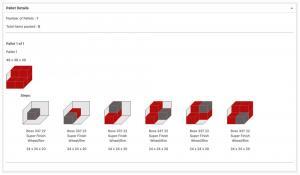
8a. Enable the pallet packaging feature. |
Return to top. |
The top of the Pallets page contains information to aid you in managing this usage-based feature. A charge of 3 cents is incurred each time the packaging algorithm executes.

| Enable checkbox | Check this box to enable the pallet packaging feature. While enabled a charge of 3 cents will be incurred for each calculated packaging solution unless the capped amount for the billing cycle has been reached. If the capped amount has been reached you can re-enable the feature by increasing the capped amount. |
| Current usage | Shows the usage of the feature at the time the page loads. |
| Capped amount | The amount entered into this field is the maximum you can be charged for the Pallet Packaging feature in a billing cycle. (Learn more about “Capped amounts” and how Shopify bills for usage charges.) |
| Notification email address | An email will be sent to the email address entered when the usage of the Pallet Packaging feature reaches 80% of the capped amount. Taking action to increase the capped amount immediately after receiving the email will mitigate the risk of the feature being disabled, which may prevent the retrieval of LTL freight quotes or, if they are retrieved, their accuracy. |
8b. Identify your pallets or handling units. |
Return to top. |
To add a pallet, click the Add Pallet button.

Follow the instructions below. Repeat for each pallet or handling unit that you stock.
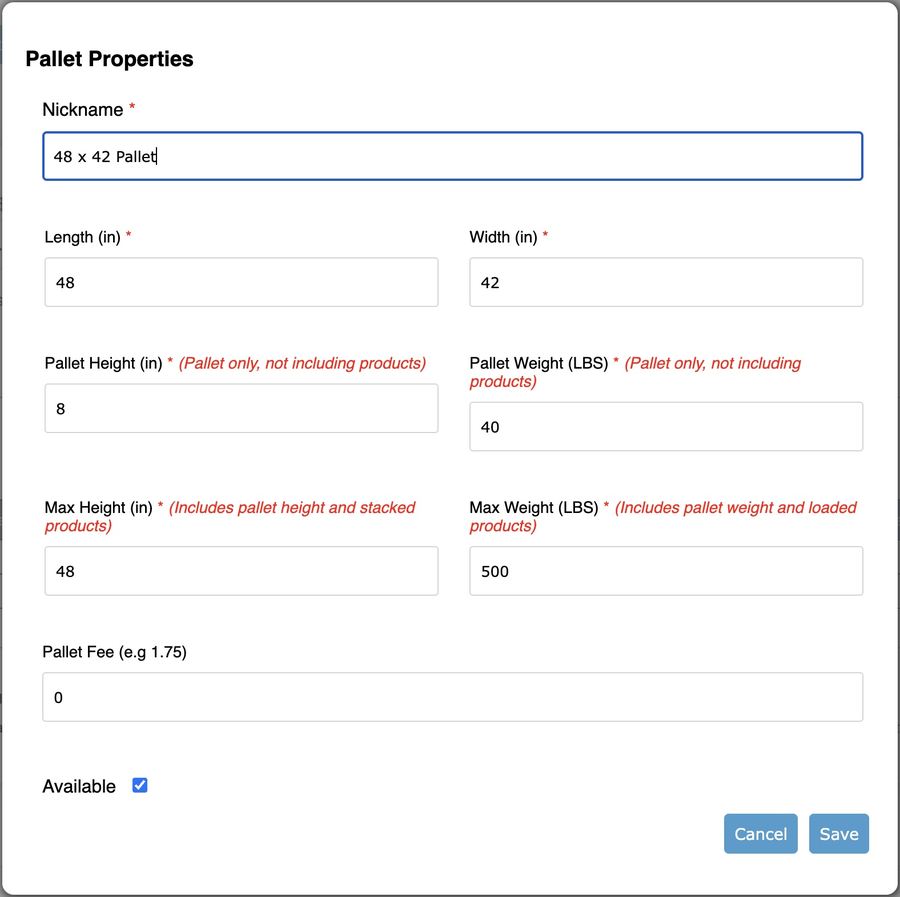
| Nickname | Enter a nickname for the pallet. This will be used to identify the pallet in the graphical representation of the packaging solution that can be viewed on the Order Detail page. The nickname is not visible to shoppers. |
| Length | Enter the length of the pallet in inches. |
| Width | Enter the width of the pallet in inches. |
| Pallet Height | Enter the height of the pallet in inches. This is the height of the pallet without anything on it. |
| Pallet Weight | Enter the weight of the pallet in pounds. This is the weight of the pallet without anything on it. |
| Max Height | Enter in inches the maximum height that you are willing to allow the pallet to reach as items are placed on it. |
| Max Weight | Enter in pounds the maximum weight that you are willing to allow the pallet to reach as items are placed on it. |
| Pallet Fee | Enter the fee associated with using this pallet. This amount will be included in the shipping cost when the pallet is used in a packaging solution. |
| Available | Enable this checkbox to make the pallet available to the algorithm that determines the packaging solution. |
8c. Items that ship as multiple pallets or handling units |
Return to top. |
When you enable the Pallet Packaging feature, a setting is available on the Product Shipping Parameters page to allow you to specify that the item ships as multiple pallets or handling units.
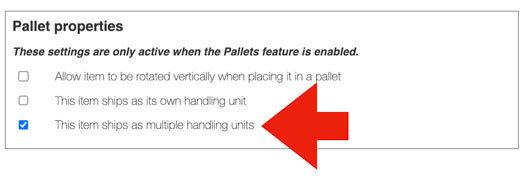
When you enable the setting, the item will appear on the Pallets page in the Items that ship as multiple handling units section.

Click the Add a handling unit link. A popup will display to collect information about the handling unit.
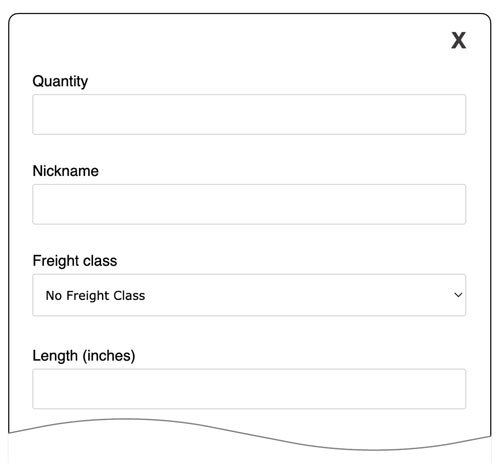
Enter the handling unit shipping parameters.
| Quantity | Enter the number of handling units that are of this size. |
| Nickname | Enter a nickname for the handling unit. The nickname will be used to identify the handling unit in the graphical illustration of the packaging solution. The nickname is not visible to shoppers. |
| Freight Class | The Freight Class of the item. If you choose Density Based, dimensions are required. Dimensions aren’t required if you choose a Freight Class other than Density Based unless the handling unit will be subject to the overlength fee (a.k.a. excessive length fee). (Learn about Freight Classes) |
| Length | The length of the pallet or handling unit in inches. |
| Width | The width of the pallet or handling unit in inches. |
| Height | The height of the pallet or handling unit in inches. |
| Weight (Required) | The weight of the pallet or handling unit in pounds. |
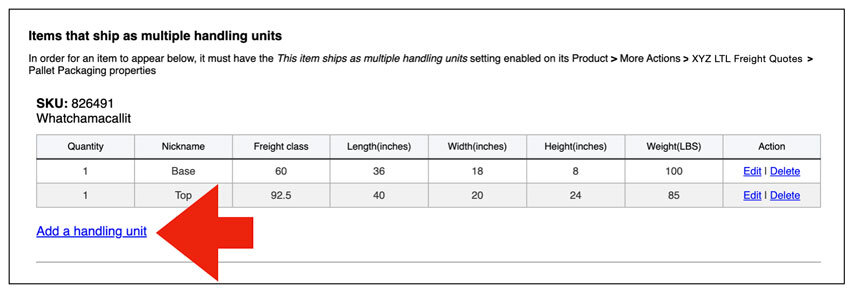
9. Shipping Rules |
Return to top. |
The Shipping Rules page gives you an opportunity to customize the behavior of the app. Use this page to filter for Carts by weight, price, and/or quantity and then apply one of the following operations:
- Choose not to display certain shipping methods.
- Add a surcharge to the shipping quotes presented at checkout.
- Apply a discount to the shipping quotes presented at checkout.
- Present a flat rate for shipping during the checkout.
If you create a rule but don’t introduce a filter, then the rule will apply to every checkout.
To introduce a rule, click the Add Rule button. Complete the form using the instructions below. Click the Save button afterward to implement the rule.
| Rule Name | Enter a name for the rule. The name is for your convenience. It will not be seen by your customers. |
| Type | Select the rule type. The following options are available:
|
| Apply to | Cart Choose this option if you want the shipping rule to apply to the entire Cart. Shipment
Choose this option if you want the shipping rule to apply only to individual shipments. For example, the app is capable of combining shipping quotes from multiple ship-from locations. If you want the rule to apply only to the shipments that meet the rule filter(s), then choose this option. If you want the rule to apply to all the shipments if any of the shipments satisfy the rule filter(s), then choose the option for Cart. |
| When the Type is “Hide Methods” | No other settings apply to this rule type. If the rule filter is met and it applies to the “Cart”, then the app will not present shipping quotes during checkout. If the rule filter is met and it applies to the “Shipment”, then the quotes for the shipment will not contribute to the sum of the shipping rates retrieved for the other ship-from locations. |
| When the Type is “Discount” or “Surcharge” | Discount/Surcharge Amount Enter a dollar amount (e.g. 5.00) or a percentage (e.g. 5.0%). |
| When the Type is “Override Rates” | Display As Enter the text that should be used to identify the rate on the Shopify Shipping Methods page. Description
Enter the text you want to accompany the “Display As” text to describe it. Often this is used to convey the expected shipping interval (“Allow 5 to 7 days for delivery”) or something about the rate (“Promotional flat rate shipping”). Flat Rate
Enter the dollar amount of the rate that will be displayed when the rule filter(s) are met. Suppress other rates
Enable the checkbox if you want the override rate to replace the rates that the app would otherwise display on the Shopify Shipping Methods page. Leave it disabled if you want the override rate to be displayed in addition to the the real-time rates that the app will display on the Shopify Shipping Methods page. |
| Filters | Filter Name Enter a name for the filters you want to implement. The name is for your convenience. It will not be seen by your customers. Filter by weight
Enable the checkbox if you want to use the weight of the cart as a criteria for the application of the rule. Enter the range for the weight in the From and To fields. The value entered in the From field will be included in the criteria. The value entered in the To field will be excluded from the criteria. If you enter “From 100” “To 150”, then a Cart with a total weight of 100 LBS will trigger the rule while a Cart with a total weight of 150 LBS will not. Consider the “To” field as the “Up to” value. Filter by price
Enable the checkbox if you want to use the price of the cart as a criteria for the application of the rule. Enter the range for the price in the From and To fields. The value entered in the From field will be included in the criteria. The value entered in the To field will be excluded from the criteria. If you enter “From 100” “To 150”, then a Cart with a total price of $100 will trigger the rule while a Cart with a total price of $150 will not. Consider the “To” field as the “Up to” value. Filter by quantity
Enable the checkbox if you want to use the quantity of items in the cart as a criteria for the application of the rule. Enter the range for the quantity in the From and To fields. The value entered in the From field will be included in the criteria. The value entered in the To field will be excluded from the criteria. If you enter “From 10” “To 20”, then a Cart containing 10 items will trigger the rule while a Cart with 20 items will not. Consider the “To” field as the “Up to” value. Filter by vendor
Enter the vendor name. The value entered must be an exact match for what you have entered on the Shopify Product Detail page in the Product Organization > Vendor field. Separate multiple entries with a comma. Filter by product tag
Enter the product tag. The value entered must be an exact match for what you have entered on the Shopify Product Detail page in the Product Organization > Tags field. Separate multiple entries with a comma. Available
Enable this checkbox if you want the rule to be applied. Disable it if you want to keep the rule settings for future use, but you don’t want to actively apply it. |
10. Enter Product Settings |
Return to top. |
Now that the application settings have been established, it’s time enter the product settings. Repeat these instructions for every product that you want to ship LTL freight. Select Products from the Shopify menu. Locate the product on the list and choose it by clicking on it. You will be delivered to the product’s details page. Click the More actions button at the top of the page to reveal the installed apps and select the app from the list.
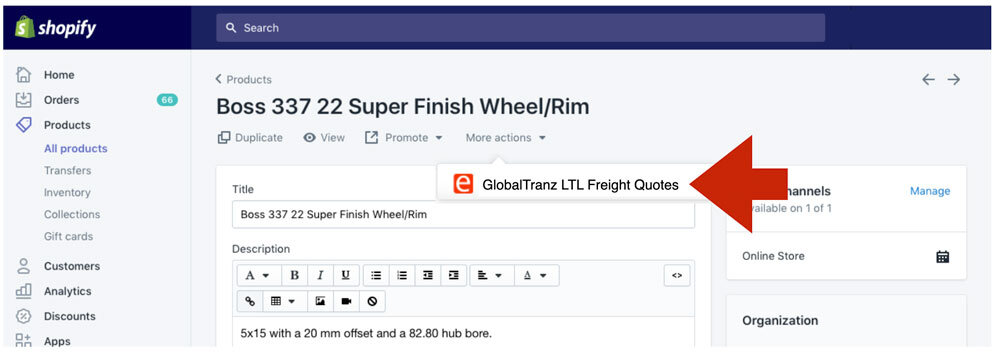
You’ll be delivered to a page on which you will enter the product’s freight class, weight and dimensions. Enter the information prompted for, and then click the Save & Return button at the bottom of the page to return to the product’s Shopify product details page.
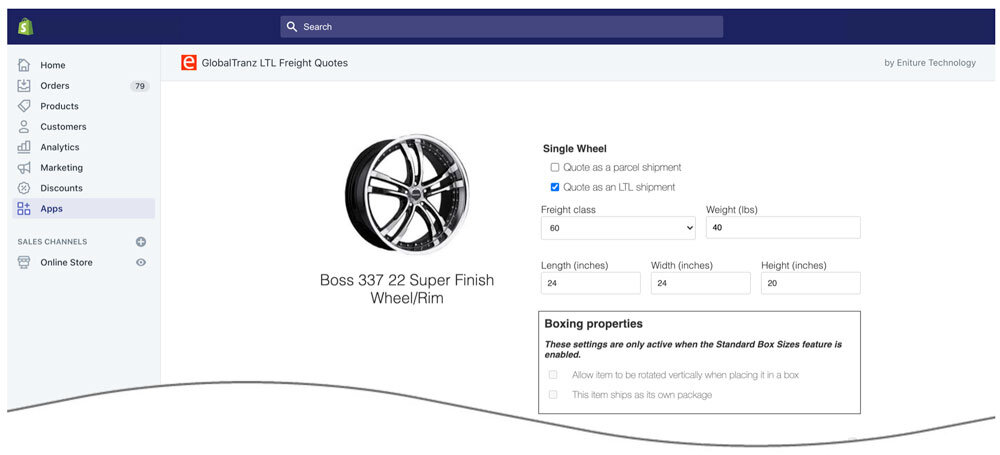
| Quote as a parcel shipment | This setting will only be present if you also have one of Eniture Technology’s Small Package Quotes apps installed. Enable this setting if a single unit of the item will ship via FedEx or UPS. An LTL quote will still be presented to the shopper when the cart weight is 150 pounds or more. Learn more: Why you should use the Small Package Quotes productThe rules that govern when parcel and/or LTL rates display |
| Quote as an LTL shipment | Check this checkbox if you always want this product to be quoted as shipping LTL freight. |
| Weight | Enter the weight of the product in pounds. Include the weight of any packaging materials that are used to ship the product. |
| Freight Class | Select the product’s freight class from the drop down list. You may also select Density Based from the list, which will calculate freight class on the fly using the product’s weight and dimensions. The density based calculation will return the correct freight class in most, but not all cases. You are solely responsible to identify the correct freight class of your product(s). If you need assistance, contact your LTL freight provider or refer to the National Motor Freight Classification (NMFC) directory published by the National Motor Freight Transportation Agency (NMFTA.org). |
| NMFC | Usually an NMFC number is not required to get an LTL freight quote. However, in certain circumstances, an LTL freight provider may require it for individual accounts. If you are required to provide a commodity’s NMFC number to obtain an LTL freight quote, enter it here. |
| Length | Optional for LTL freight quotes. Enter the length of the product in inches. It should include any incremental inches added by packaging materials that may be required to ship the product. The length field is used to trigger overlength (aka excessive length) fees, so you should enter the length if the item will be subject to this fee. |
| Width | Optional for LTL freight quotes. Enter the width of the product in inches. It should include any incremental inches added by packaging materials that may be required to ship the product. |
| Height | Optional for LTL freight quotes. Enter the height of the product in inches. It should include any incremental inches added by packaging materials that may be required to ship the product. |
| Fulfillment Offset Days | The Standard Plan is required to use this setting. The setting is only relevant if you have the Display estimated delivery date setting enabled on the Quote Settings page.
When the app requests shipping quotes, it identifies a ship date. The estimated delivery date is dependent on the ship date. The Quote Settings page has three settings that are applied globally that will alter the ship date so that it aligns with your fulfillment operations. The product-level setting for Fulfillment Offset Days allows the offset to be different for individual products. The product-level setting for Fulfillment Offset Days takes precedent over its globally applied counterpart on the Quote Settings page. In cases where the Cart contains multiple products with different Fulfillment Offset Days, the largest number of offset days is used to adjust the ship date. Enter the number of days to offset the ship date for this product. If you don’t need a unique setting for this product, leave it blank. |
| Handling Unit Settings | These settings are relevant only if you are using an Eniture Technology product that retrieves LTL freight quotes. Skip these settings (leave them blank) if you are not.
The Quote Settings page has handling unit settings that are applied globally. If different handling unit settings are required for an individual product, enter them here. Leave these settings blank to utilize the global handling unit settings on the Quote Settings page. Product-level handling unit settings take precedent over the global handling unit settings. Weight of handling Unit
Enter in pounds the weight of your pallet, skid, crate or other type of handling unit you use. The amount entered will be added to shipment weight for this product prior to requesting a quote. Maximum Weight per Handling Unit
Enter in pounds the maximum weight that can be placed on the handling unit. If the total weight of the the product exceeds this value, the weight of additional handling units will be added as needed. For example, if the maximum weight is 500 LBS, and the total weight in the Cart for the product is 1200 LBS, the weight of the handling units added to the shipment shall be 3 times the weight entered in the Weight of Handling Unit field. (=roundup(1200/500,0)*Weight of Handling Unit) |
| Nested item | The Advanced Plan is required to use this feature. If you aren’t on the Advanced Plan the words Advanced plan required will appear adjacent to the settings header, and the fields associated with the feature will be inaccessible.
Enable this checkbox if the item can be stacked into another identical item when it is shipped. An example would be 13 gallon trashcans or plastic cups. When this setting is enabled, the Freight Class is always Density Based. |
| Nested dimension | This setting is only relevant if the Nested item setting is enabled.
Identify the dimension (length, width or height) on which the nesting occurs. |
| Nesting percentage | This setting is only relevant if the Nested item setting is enabled.
Enter the percent of the item that can be nested inside of another identical item. For example, if an item is 10 inches in height and after stacking two together the total height is 11 inches, the stacking percentage is 90%. (11 inches = 10 inches + (10 inches x 90%)) |
| Maximum nested items | This setting is only relevant if the Nested item setting is enabled.
Enter the maximum number of items you’ll allow in a single stack of nested items. |
| Stacking property | This setting is only relevant if the Nested item setting is enabled.
Select Maximized or Evenly. If your Maximum nested items is 6, and there are 7 items in the cart, then the Maximized option will result in one stack of 6 and one of 1. If the Stacking property is set to Evenly, it will result in one stack of 4 and one of 3. |
| Pallet properties | These settings require the optional Pallet Packaging feature to be enabled.
Allow item to be rotated vertically when placing it on a pallet
Enabling this setting allows the item to be rotated while identifying a packaging solution using the Pallet Packaging feature. This setting provides the most flexibility for arriving at a packaging solution. This item ships as its own handling unit
When enabled, the item will be quoted as shipping as it own handling unit. It will not be combined with other items on a common handing unit. Packaging algorithm usage charges are not incurred for items with this setting. This item ships as multiple handling units
When enabled, the item will be listed on the Pallets tab in the section for items that ship as multiple handling units. Refer to the section in the User Guide that documents how to define items that ship as multiple handling units for instruction. Packaging algorithm usage charges are not incurred for items with this setting. |
| Markup | Enter a dollar amount (e.g. 5.00 for $5.00) or a percentage (e.g. 5.0% for five percent) to mark up the shipping charges when this item is in the cart. Leave this field blank if you don’t want the inclusion of this product in the cart to be the reason why the shipping quotes that are returned by the carrier are modified.
A dollar amount will be multiplied by the quantity of the item that is in the cart and the result added to the shipping quotes that are returned from the carrier before any markups on the Quote Settings page are applied. A percentage will be applied to the total value of the item in the cart (price x quantity x (1 + markup percentage)) and the result added to the shipping quotes that are returned from the carrier before any markups on the Quote Settings page are applied. |
| Hazardous Material | The Standard Plan or higher is required to use this feature. If you aren’t on the Standard Plan or higher the words Standard plan required will be displayed. Click on the Standard plan required text to upgrade your plan and gain access to the feature. You must be signed into Shopify with the Store Owner credentials to perform the upgrade.
Check this checkbox if this item must be identified as hazardous material. When checked, the carrier’s hazardous materials fee will be included in the quote if this item is present in the cart. |
| Drop ship this product | Check this box if this item is drop shipped from a location other than your warehouse. |
| Drop ship location | Select the drop ship location from the drop down. These locations are created on the Warehouse tab in the app settings that was described in step 6. |
Logs |
Return to top. |
The Quote Settings page contains the Enable Logs setting. When enabled, the app’s navigation will include a tab to the Logs page. Up to 25 of the most recent transactions will appear on the Logs page. The Response column shows the outcome of each transaction. Click on a transaction’s response result to view its details.
When viewing the transaction details, click on the “+” symbols to expand the level of detail and “–” to collapse it. A basic understanding of Application Programming Interfaces (APIs) will be useful when viewing the logs.
What your customer sees |
Return to top. |
Once you’ve completed the preceding steps, your Shopify store is ready to begin quoting LTL freight. Any time one or more products in the shopping cart are flagged as shipping LTL freight, all of the products are assumed to ship LTL freight as this will be more economical than splitting the shipment between two or more shipping methods. In the absence of a freight class, as may be the case for products not set up to ship LTL freight, the application will take advantage of any available information to ensure the return of an LTL freight quote if at all possible. To ensure the best possible outcome, it is highly recommended that the freight class, weight and dimensions be entered for every product you sell, even if they are not defaulted to ship LTL freight. When LTL rates are displayed, the exact presentation will depend on the options selected in the Quote Settings.
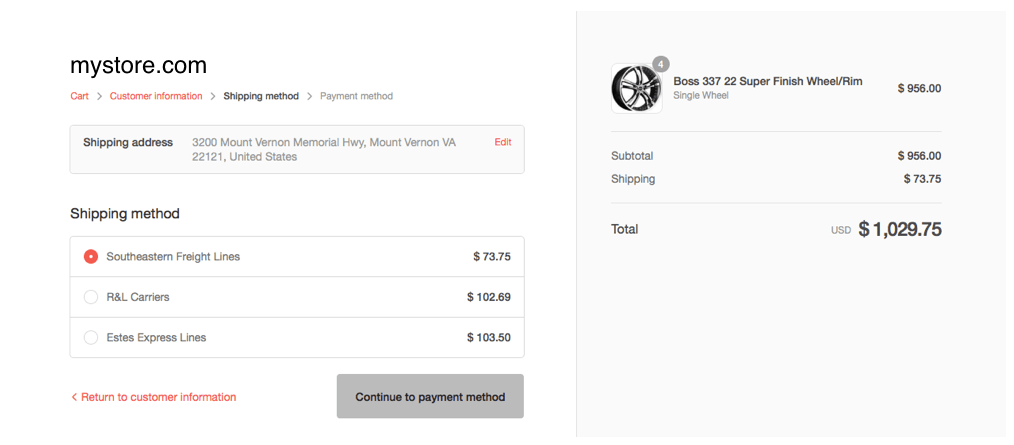
What you see. |
Return to top. |
The app populates shipping related information in the Additional details widget on the Order Details page. The content of the widget falls into two categories: 1) Shipment Origin & Services; and 2) Shipment Content.
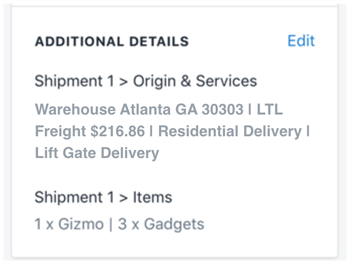
Shipment Origin & Services
This information block will identify the shipment origin, the selected carrier service and a list of any additional services (such as residential delivery) associated with the shipment. A separate Shipment Origin & Services information block will appear for each shipping location that will participate in fulfilling the order. This is particularly useful for stores with multiple warehouses and drop ship locations.
Shipment Content
A Shipment Content information block is presented beneath each Shipment Origin & Services information block. It identifies the products that were quoted as shipping from the location.
Updating products with the Import CSV Utility or API. |
Return to top. |
Using the app’s user interface is the simplest to populate the product shipping parameters. However, if your store has a lot of products, using the app’s Import CSV Utility or its Product API will be more time efficient for people with sufficient technical skills. Which method is used will depend on the individual’s level of expertise. Instructions for both appear below.
You can’t use the Import CSV utility or the Products API to create products in Shopify. The products must exist in Shopify prior to downloading the CSV template or using the API if they are to be updated.
Using the Import CSV Utility |
Return to top. |
Navigate to the Import CSV tab in the app preferences.

Use the link below to access instructions on how to…
- Download the CSV template.
- Use the filters to isolate the product/variant records you want to update.
- Populate the CSV file with your shipping parameters.
- Save the CSV file in the proper format.
- Import the CSV file to the app.
Using the Product API |
Return to top. |
Navigate to the Import CSV tab in the app preferences.

Scroll to the bottom of the page to the section titled, Update product shipping parameters via the API.

If an API token isn’t present, click the Create button. Copy the API token to your clipboard and follow the instructions in the Product API documentation which is linked below:
Shipping with FreightDesk Online |
Return to top. |
- How capture the cost of shipping on orders placed online.
- How to ship the order, including how to create the shipping label (or Bill Of Lading in the case of LTL freight), schedule the carrier to pick up the shipment, and update the customer with the tracking number.
Quoting apps, like this one, provide a solution for the first challenge. What are your options for the second challenge?
Option 1 – The carrier’s website: You can log into the carrier’s website and manually enter all of the relevant information. Carrier websites are free to use since the carrier makes money when you use them to deliver an order. However, if you have more than a handful of orders each day this approach is time consuming and ripe for data entry errors which can be costly to correct.
Option 2 – Shopify Shipping: Shopify Shipping offers pretty competitive rates for postal companies like the US postal service, and parcel companies like UPS, and DHL. But if you ship with another provider or have more than a low-to-moderate number of daily orders, you’ll find Shopify Shipping clunky and woefully inefficient.
Option 3 – Cloud-based Shipping Platforms: The next step up in capability are cloud-based shipping systems that will connect to your online store and retrieve the details of your orders, thereby eliminating the need for much of the manual data entry. Many of these shipping systems have arrangements with postal and parcel carriers that are on par if not better than the options available through Shopify Shipping. Where these systems excel is in the efficiency of the fulfillment process. That translates in to a much higher volume of shipments per unit of time. These systems are relatively inexpensive and the reduction in the amount of labor and time it takes to ship your orders will pay dividends.
Option 4 – FreightDesk Online: FreightDesk Online (freightdesk.online) is also a cloud-based shipping system. It enjoys all of the benefits of other cloud-based offerings but expands the solution in two ways:
- It makes use of the detailed information collected by Eniture Technology’s quoting apps (like this one) such as the packaging solution and the additional services included in the shipping option chosen when the order was placed.
- It provideds merchants access to more than two dozen LTL freight providers in addition to the typical postal and parcel integrations offered by other cloud-based solutions.
These expanded capabilities deliver you closer to true “click-and-ship” shipping than any other alternative, whether you’re shipping with a postal carrier, a parcel carrier, or an LTL freight provider.
How to connect your Shopify store to FreightDesk Online |
Return to top. |
First, if you don’t already have one, register for a FreightDesk Online account (https://freightdesk.online/register). You can connect multiple online stores to FreightDesk Online, so you don’t have to create separate accounts for each one.
The pricing for FreightDesk Online is á la carte. You’ll be able to pick a separate plan for parcel (and postal) shipments, and for LTL freight shipments based on the anticipated volume for each type of shipping. Your monthly subscription rate will be comprised of these two selections. You can begin a 30-day trial of both types of shipping by selecting Trial in the corresponding dropdown fields on the registration form.
After you complete the registration process, log into FreightDesk Online. Click on your avatar located in the top right-hand corner of the browser window. Copy your FreightDesk Online ID which will be located below your company name.
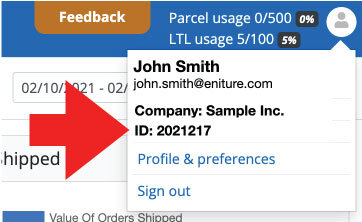
Return to the app preferences and click on the FreightDesk Online tab. Enter your FreightDesk Online ID and click the Connect button.
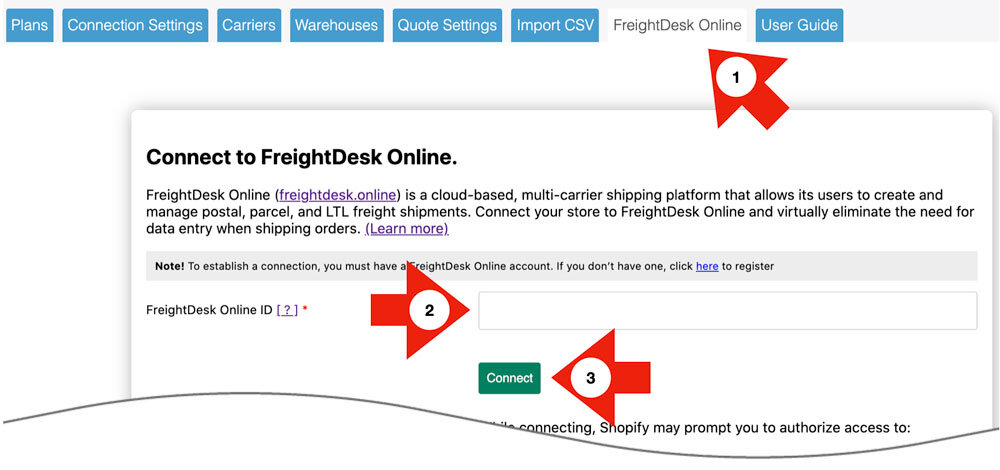
Complete the connection by granting the permissions that Shopify prompts you for.
Now that you’ve connected FreightDesk Online, unfulfilled orders will automatically appear in FreightDesk Online. To view them, log into FreightDesk Online and click on Orders in the navigation menu. You’ll need to connect your shipping providers before you can start shipping. You can find a quick start guide in FreightDesk Online by navigating to Help > Getting Started.
Using Validate Addresses |
Return to top. |

– Benjamin Franklin
Shipping to invalid addresses is expensive and avoidable. The cost of failed deliveries, returned shipments, and carrier fees can quickly change a profitable sale into a loss. Without interfering with the Shopify checkout process, Eniture Technology’s DIY Validate Addresses app immediately identifies orders that are safe to ship or notifies customers to confirm or correct the address. Customer updates are instantly reflected in Shopify so you know when it’s safe to ship the order.
The peace of mind knowing that you are shipping to a valid address can cost as little as 1¢ per order. The DIY Validate Addresses app is available in the Shopify App Store, and more detailed product information, including the User Guide, is available on eniture.com. The links below will take you to these resources:
DIY Validate Addresses Shopify App Store Listing
DIY Validate Addresses product information on eniture.com

